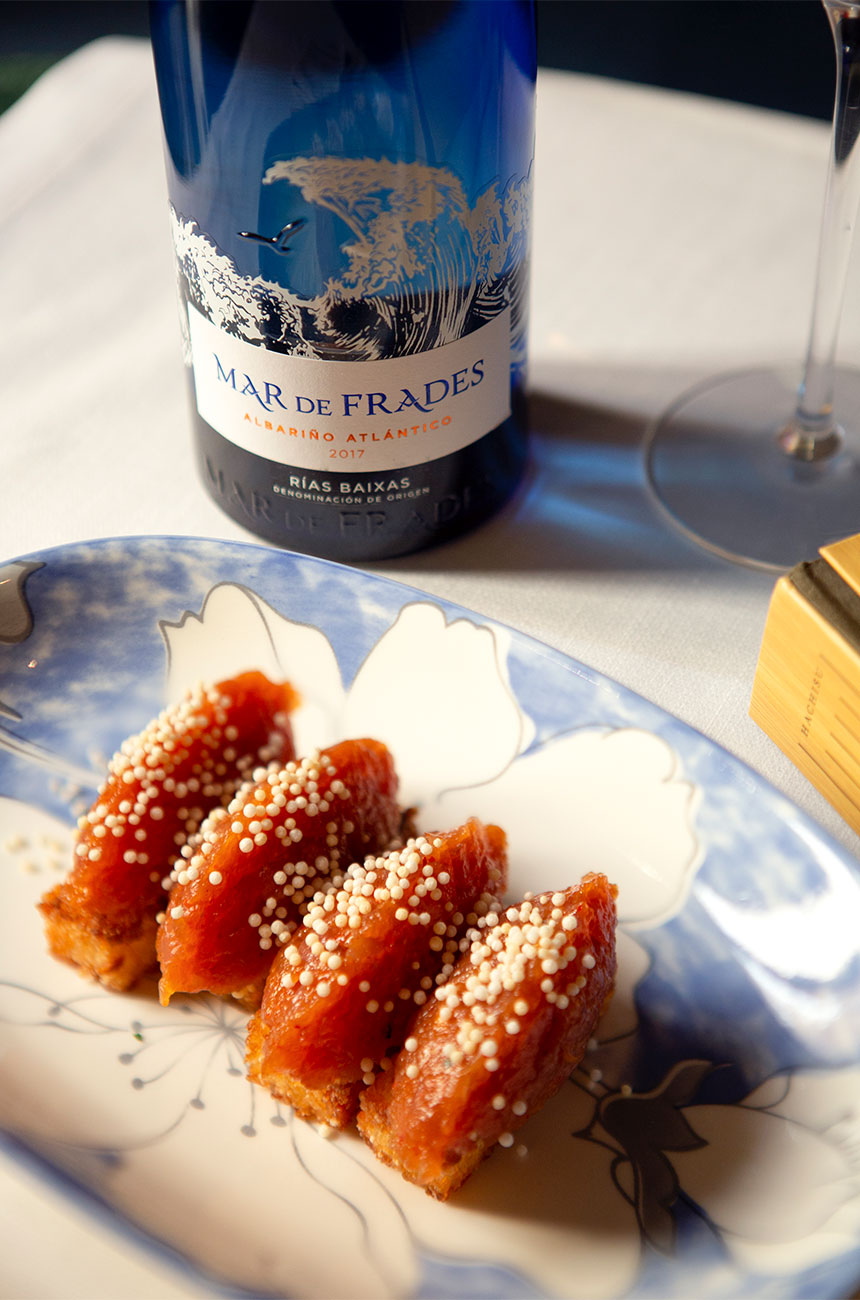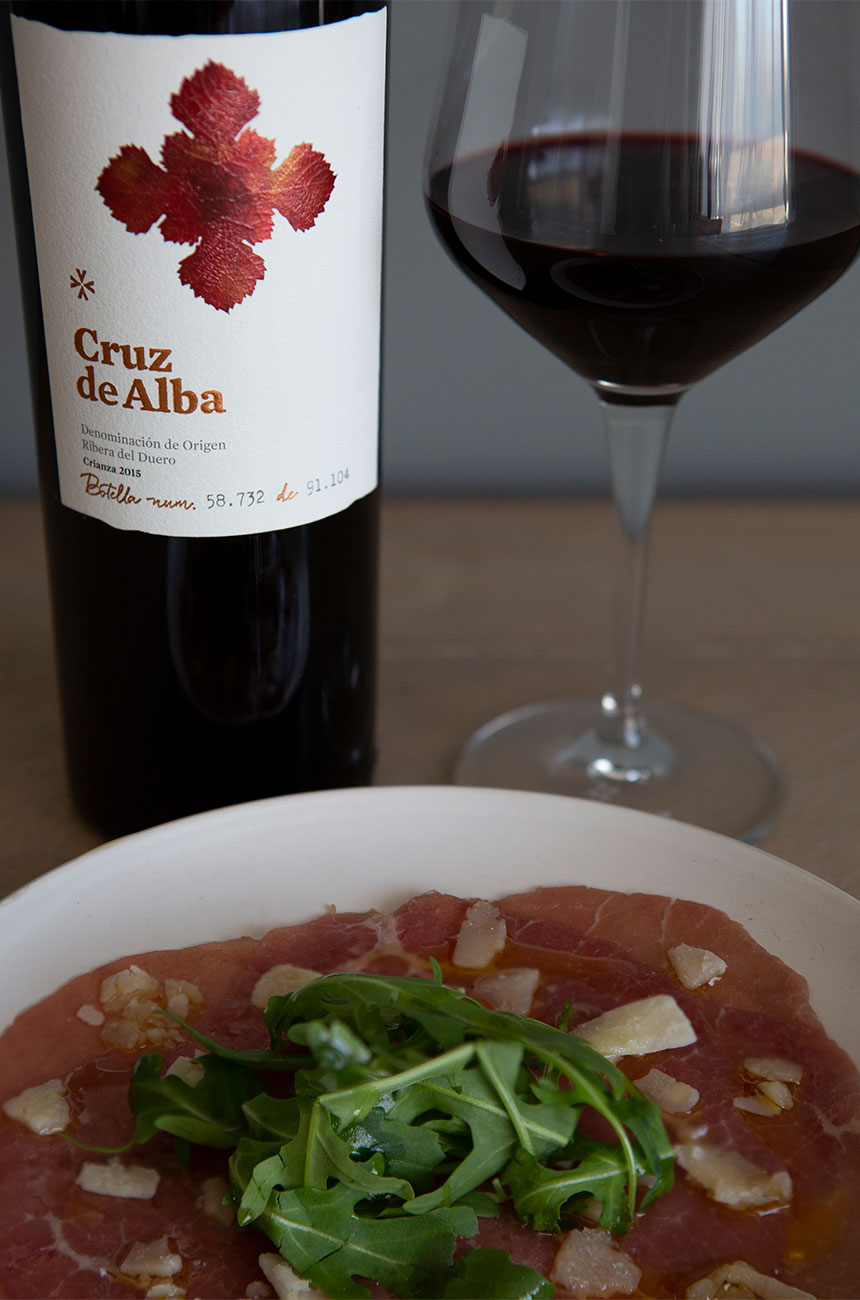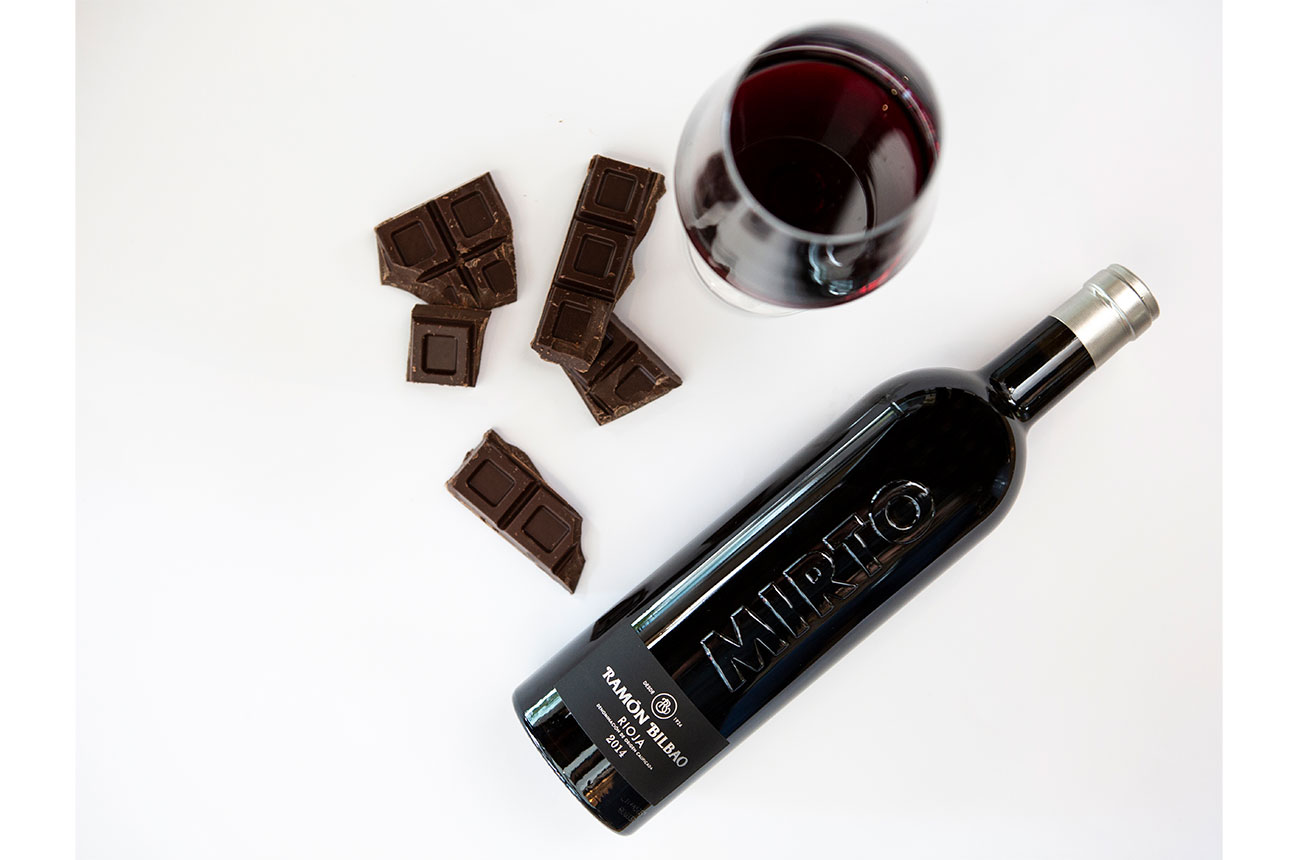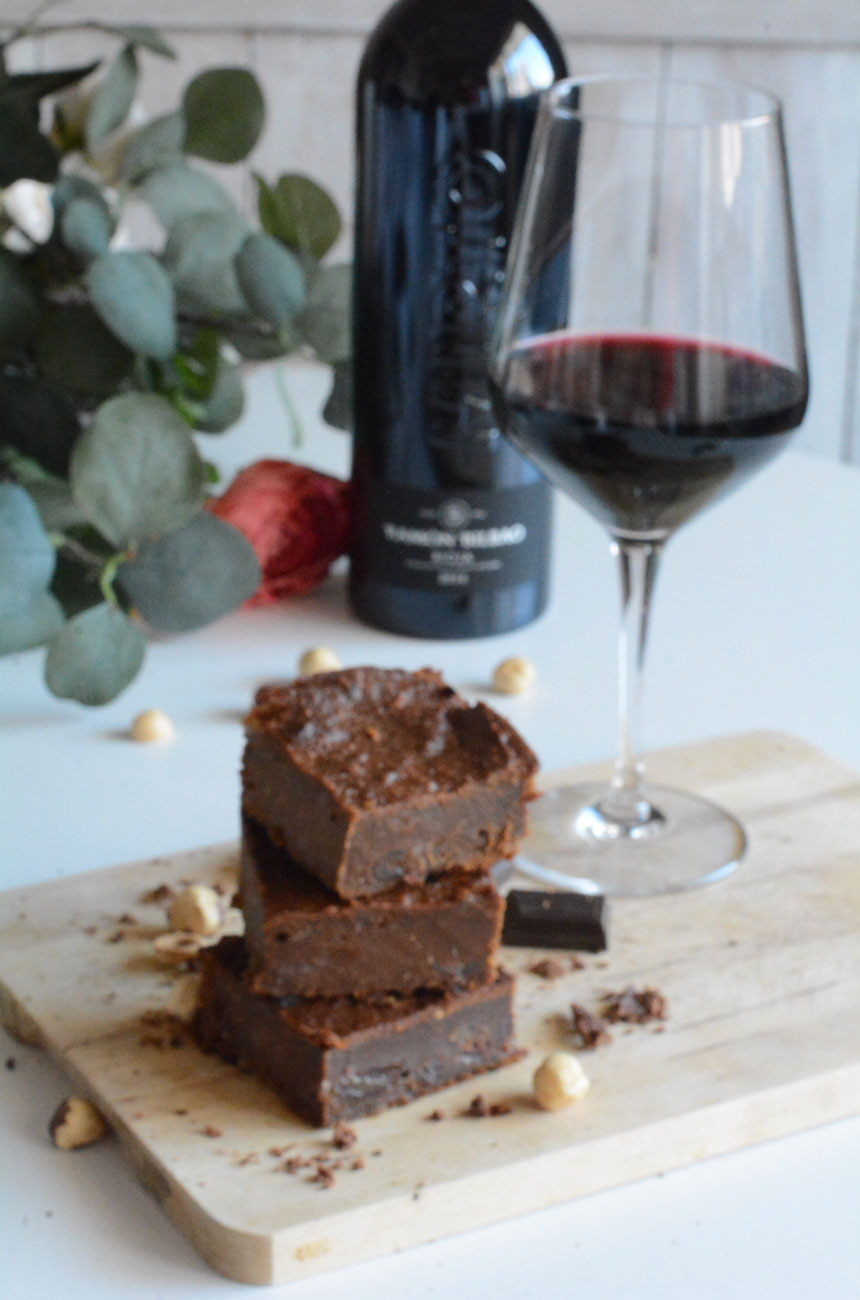Anyone who has travelled in Spain will know that there is always a delicious wine to pair with the local food wherever you are in the country. As in other European wine-producing nations, food and wine has grown up side by side.
There’s a lot to be said for sticking to tried and trusted pairings – the inhabitants of Rioja and Ribera del Duero, for example, share a taste for local lamb. But both food and wines evolve and in all parts of Spain, a country that has developed a reputation for its cutting-edge gastronomy, you’ll find restaurants playing with new and exciting flavour combinations.

Rías Baixas
The wine: Mar de Frades, Albariño
The dish: Pulpo a la Gallega
The cuisine
If ever there was a more classic example of the dictum that ‘what grows together goes together’, it’s in Galicia, where the abundant seafood is perfectly suited to the local Albariño. There’s scarcely a type of shellfish that isn’t available; but ironically the signature dish of the region is not mariscos, as they call them in Spain, but octopus.
Pulpo a la Gallega (‘a la gallega’ means in the Galician style), also known as pulpo a feira, is a simple dish of boiled octopus served with sliced potatoes, olive oil and spicy pimento, and served as a tapa or street food snack. The crisp saline Albariño cuts through the richness perfectly.
Less challenging – apart, perhaps, from the ugly percebes or goose barnacles – is the mariscada Gallega. This is a mixed seafood platter, which typically includes crabs, clams, oysters and mussels. Galicians also have their own version of empanadas, which more commonly take the form of a large pie rather than a hand-held pasty. Tuna is the most popular filling, flavoured with onions and tomatoes and known as an empanada de atun.
And who knew that Galicia is where pimientos de Padrón, now ubiquitous throughout Spain, come from? Another good snack with a glass of Albariño providing you don’t get an eye-wateringly hot one!

Ribera del Duero
The wine: Cruz de Alba, Crianza
The dish: Roast milk-fed lamb
The cuisine
Those outside the region may regard it with horror, but lechal or milk-fed lamb, is a noted Spanish delicacy that’s much prized by food and wine lovers alike. You might think a powerful wine would overwhelm such delicate meat but the two complement each other perfectly, especially with more mature vintages.
The meat is served on its own with just the cooking juices. No heavy charring, no sauce, no gravy. No competing ingredients on the plate. Suckling pig and kid are often served a similar way. It’s really only older animals that are given more robust treatment in stews that are generously seasoned with garlic, peppers and pimenton.
Ribera wines also go well with the cured meats that are popular in the region. Ham, of course – no Spanish meal would be complete without it – but also other more local specialities such as lomo, chorizo and cecina (smoked cured beef). You’ll also find chorizo on sale as a fresh sausage, along with morcilla (black pudding), which works particularly well with the deep ripe fruit of Ribera wines.
Then there’s always cheese. Ribera, like Rioja, pairs well with a cheeseboard and especially with piquant sheep cheeses such as Manchego, Zamorano and Castellano. You should also try Ribera wines with the wonderful goat cheese Monte Enebro.

Rioja
The wine: Ramón Bilbao, Mirto, Rioja
The dish: Braised ox cheek in red wine sauce
The cuisine
Rioja has a similar food culture and range of ingredients to Ribera del Duero but a greater diversity of wine styles. While aged gran reservas go well with traditional specialities such as lamb cutlets cooked over vine cuttings, more innovative wines like Mirto can handle the bolder flavours of dishes such as slow-cooked ox cheek in red wine (Rioja, obviously).
In fact beef rather than lamb is the way to set off these more modern styles, with more intense charring than the light grilling you would give milk-fed lamb. A big T-bone steak – chuleton – home-cooked or from a churrasquiera (steakhouse) is a fine thing to have with a glass of Rioja. As is almost any hearty dish based on beans or patatas a la Riojana – potatoes cooked with spicy chorizo, a dish that can sometimes be expanded to include pork ribs too.
That affinity with spicy food can also lead you to other culinary traditions such as American barbecue and meat-based curries.
Being on the border of the Basque country Rioja is also near the epicentre of Spain’s cutting-edge gastronomy, which means that anything is up for grabs with food and wine pairing. You could be bold and serve a modern Rioja like Mirto with foie gras, for example, or, as I discovered on a trip to the region, with chocolate cake. (Think black forest gateau and it makes sense!)
Rueda
The wine: Rueda Verdejo
The dish: Arroz negro (black rice with squid)
The cuisine
Although viticulture in the region goes back to the Middle Ages, today Rueda is all about fresh, crisp white wine – Spain’s most popular one, as it happens.
From the multitude of dishes with which it works I’m picking arroz negro – black rice with squid ink and allioli (garlic mayonnaise) the kind of dish you’ll find all over Spain, not just in the region. Rueda also goes brilliantly with other shellfish such as gambas (prawns), razor clams and mussels; with anchovies; with simple grilled sardines and – particularly good – with salt cod croquetas. Think of a fishy tapa and Rueda will partner it perfectly.
More surprisingly you’ll find Rueda Verdejo goes remarkably well with grilled lamb – acting almost like a squeeze of lemon.
It’s also a natural for the lighter, more plant-based food you’ll find in the smart modern tapas bars and restaurants in the capital city of the region, Valladolid, including asparagus, peas, courgettes, red peppers and tomatoes, as well as fresh tomato-based dishes like salmorejo (a similar dish to gazpacho with bread added). It’s perfect with crunchy salads, especially those that include goat cheese and fresh herbs such as parsley, dill and mint. And you really need to try it with the decadently gooey torta de Barros cheese!
Spanish Wine Academy from Ramon Bilbao
A note from our sponsor

The wine: Ramón Bilbao, Mirto, Rioja
The dish: Chocolate and sweet potato brownie
As unlikely as it may sound, this is an ideal dish to pair with Mirto, a complex, distinctive wine, ahead of its time, which brings certain special nuances to make a perfect match with this dessert.
Ingredients
- 800g baked or boiled sweet potato (about 3 sweet potatoes)
- 140g rice flour
- 80g ground almonds
- 12 natural dates (or 6 medjoul dates)
- 50ml almond milk (or any other vegetable drink)
- 100g olive oil
- 100g chopped hazelnuts
- A few drops of vanilla essence
- 80g de pure cocoa powder
- 1 pinch of salt
- Hazelnut butter to decorate (optional)
Method
Pre-heat the oven to 200°C.
Put all of the ingredients in a food processor, except the chopped hazelnuts and hazelnut butter. Blend well. The mixture should be even and well-mixed with a denser consistency than a normal sponge mix.
Add the chopped hazelnuts and stir them evenly into the mixture.
Tip the mixture into a rectangular baking tray (ideally measuring 20cm x 26cm).
Line the mould with greaseproof paper so that it does not stick.
Bake at 180°C for approximately 45 minutes. ⠀
Remove from the oven and leave to cool completely before turning it out of the tray.
Remove the brownie from the tray and decorate it with strands of hazelnut butter.
Serve warm (just a few seconds in the microwave before serving is enough) with a scoop of vanilla ice cream or a quenelle of coconut cream.
Variations:
- Use pumpkin instead of sweet potato
- Use oatmeal, buckwheat or wheat flour instead of rice flour
- Use your favourite vegetable drink or milk
- Replace the chopped hazelnuts with walnuts or any other chopped nuts








